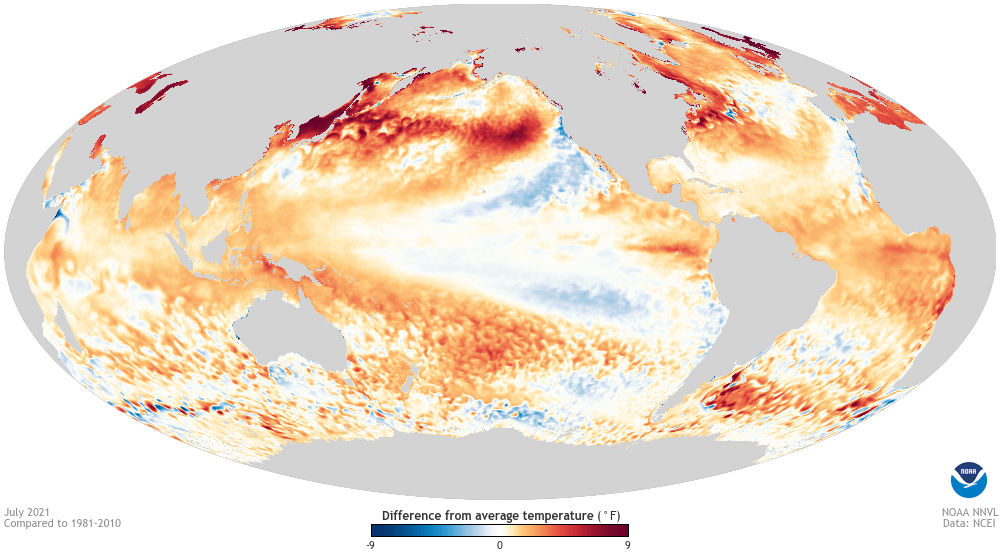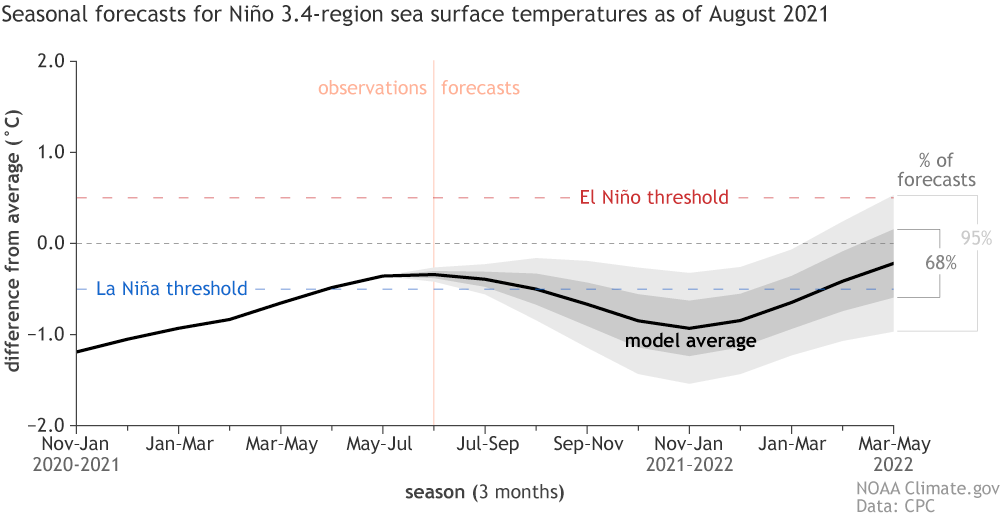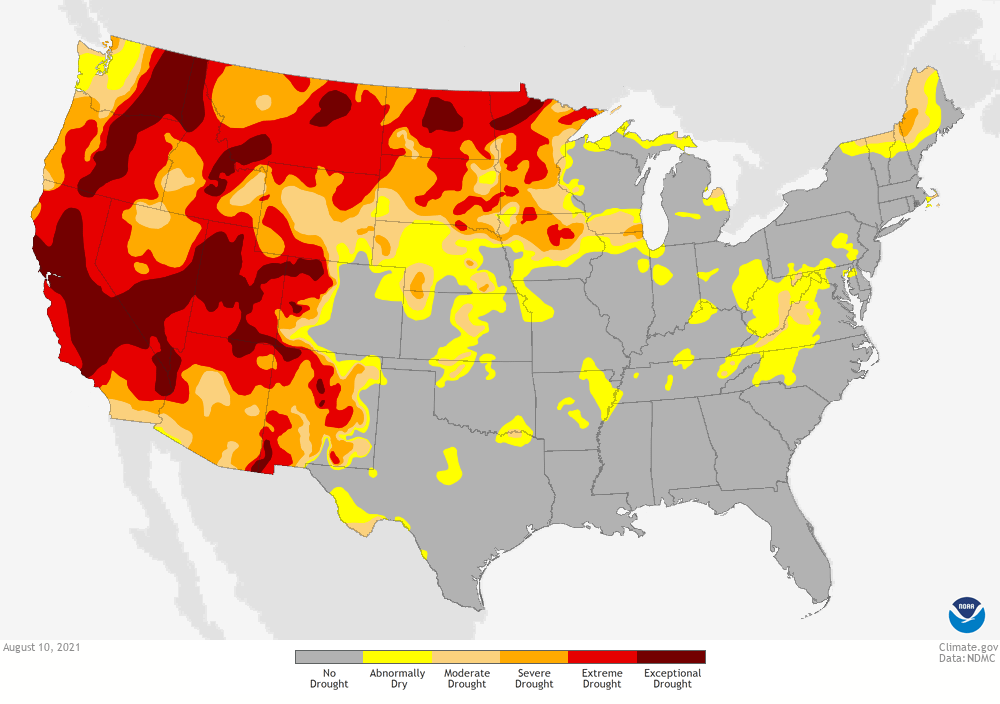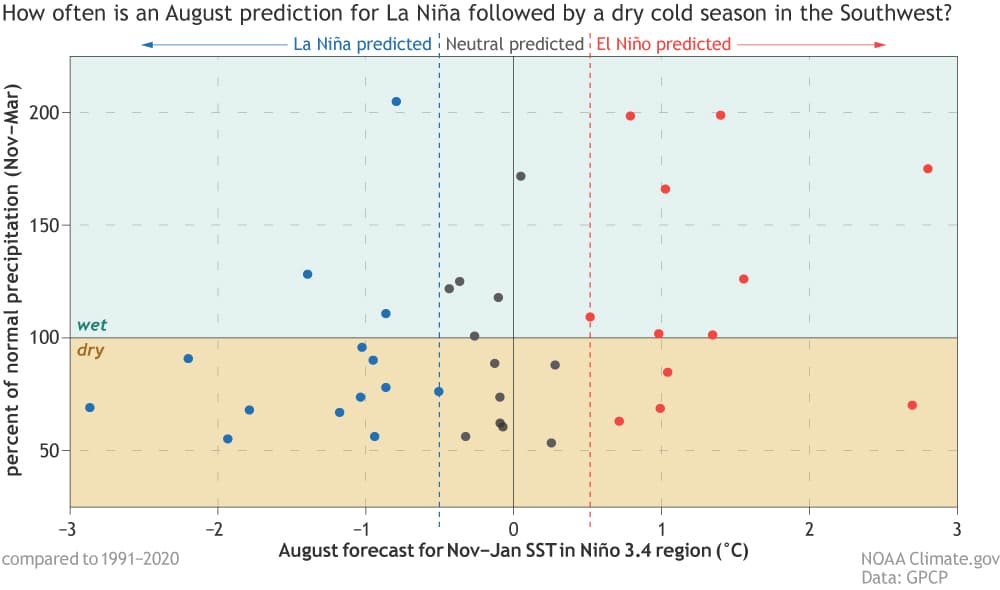NOAA: Forecasters Increase Likelihood of La Niña Winter to 70%

July 2021 sea surface temperature departure from the 1981-2010 average. Image from Data Snapshots on Climate.gov.
This post first appeared on the climate.gov ENSO blog and was written by Nat Johnson
ENSO-neutral conditions continue in the tropics, but ENSO’s next performance may be approaching, as forecasters have increased the likelihood (~70% probability) that La Niña will reemerge by early winter. A La Niña Watch remains in effect.
Wind of change
If you just took a very quick look at the tropical Pacific surface, you might think things haven’t changed much since last month. The July sea surface temperature in the Niño 3.4 region, the main region we use to monitor ENSO (ENSO = El Niño-Southern Oscillation, the whole El Niño, and La Niña system), was 0.33°C below the 1991–2020 average. This departure from average is firmly within ENSO-neutral territory and is similar to the departure that Tom described last month.
But regular readers of the blog know that we also need to scratch beneath (and above) the surface with ENSO. When we do, we see that there have been some major changes in July. First, looking below, we see that the subsurface tropical Pacific Ocean temperatures took a sharp downward turn over the past month, breaking the string of several months of above-average tropical Pacific Ocean temperatures. If these below-average subsurface temperatures persist, then they may provide a source of cool water for the onset of the next La Niña.
Next, we look up at the atmospheric arm of ENSO, the anomalous Walker circulation, which also may be giving us some hints that La Niña is itching for a return. La Niña brings a stronger-than-average Walker circulation, meaning stronger-than-average east-to-west trade winds, higher-than-average pressure in the eastern Pacific, and lower-than-average pressure in the western Pacific. We have two indexes that measure this pressure relationship, the Southern Oscillation Index and the Equatorial Southern Oscillation Index, which are based on different locations where the pressure is recorded. Both indexes show an upward jump in July, indicating that the Walker circulation strengthened. In fact, the July Southern Oscillation Index value was the highest since last February when La Niña conditions were present.
Tomorrow never knows

Climate model forecasts for the Niño3.4 Index. Dynamical model data (black line) from the North American Multi-Model Ensemble (NMME): darker gray envelope shows the range of 68% of all model forecasts; lighter gray shows the range of 95% of all model forecasts. NOAA Climate.gov image from University of Miami data.
So, are these recent changes just a temporary blip or a sign of ENSO’s warm-up act?
The latest forecast from the North American Multi-Model Ensemble (NMME) suggest they may be more than a blip, indicating a likelihood that the surface temperatures in the Niño 3.4 region are about to dip downward. Moreover, most model forecasts predict the onset of La Niña by fall. The forecast from the NOAA Climate Prediction Center is in good agreement with these computer models, forecasting a 60-70% probability of La Niña between fall and winter of 2021/22. The likelihood of El Niño is extremely low (less than 4%) during this period, so if La Niña doesn’t develop, then it’s a good bet that we would remain ENSO-neutral. If La Niña does redevelop, it would be the second winter in a row, which is a rather common occurrence.
Have you ever seen the rain?

Drought conditions across the contiguous United States as of August 10, 2021, with areas that are “abnormally dry” colored yellow, and places with increasing levels of drought colored in darker shades of orange and red, with “exceptional drought” colored darkest red. NOAA Climate.gov map from Data Snapshots, based on data from the U.S. Drought Monitor project.
The possible return of La Niña is an understandable concern for our friends in the western US, who have endured terrible drought and the accompanying extreme heat and devastating wildfires.
The focus of concern from an ENSO perspective is the Southwest, given that La Niña is linked to reduced rain and mountain snowfall over the region from late fall through winter.

he relationship between southwestern US cold season precipitation and forecasts for early winter ENSO issued by the North American Multi-Model Ensemble (NMME) in August. The y-axis shows the percentage of accumulated cold season (November – March) precipitation relative to the 1991-2020 average. The x-axis shows the model average August forecast for the early winter (November – January) Niño 3.4 Index, with blue dots indicating forecasts of La Niña conditions (Niño 3.4 Index less than -0.5°C), black dots indicating neutral-ENSO forecasts (Niño 3.4 Index greater than -0.5°C but less than 0.5°C), and red dots indicating forecasts of El Niño conditions (Niño 3.4 Index greater than 0.5°C). The southwestern US precipitation is averaged over all land regions between 30°N and 38°N and between 102°W and 125°W. The data cover all winters from 1982-2020. Precipitation data from GPCP via ESRL PSL; image by Climate.gov.
So, what does the current ENSO forecast mean for the ongoing drought over the southwestern US? To give some perspective, I went through the archive of all NMME August ENSO forecasts from 1982 – 2020 (1) and looked at the relationship between the forecast for ENSO in November – January (the typical peak season of El Niño and La Niña) and the actual November through March precipitation over the southwestern US. The scatter plot above shows this relationship for the precipitation averaged over the southwest region extending about as far north as San Francisco, California, and as far east as Amarillo, Texas (2).
The plot above reveals an unfortunate tendency that we may have suspected: most (11 of 14) August NMME forecasts that predicted a winter La Niña, like the current forecast, were tied to below-average precipitation in the southwestern US.
However, there were a few La Niña-predicted winters near average and even a few above average, including the wettest winter during the period (3). Therefore, we can conclude that the current forecast suggests that substantial drought relief may not be likely for the Southwest this winter, but there is still a considerable amount of uncertainty at this time and no reason to give up hope!

NOAA: Forecasters Increase Likelihood of La Niña Winter to 70% - SnowBrains
Forecasters have increased the likelihood (~70% probability) that La Niña will reemerge by early winter. A La Niña Watch remains in effect.


